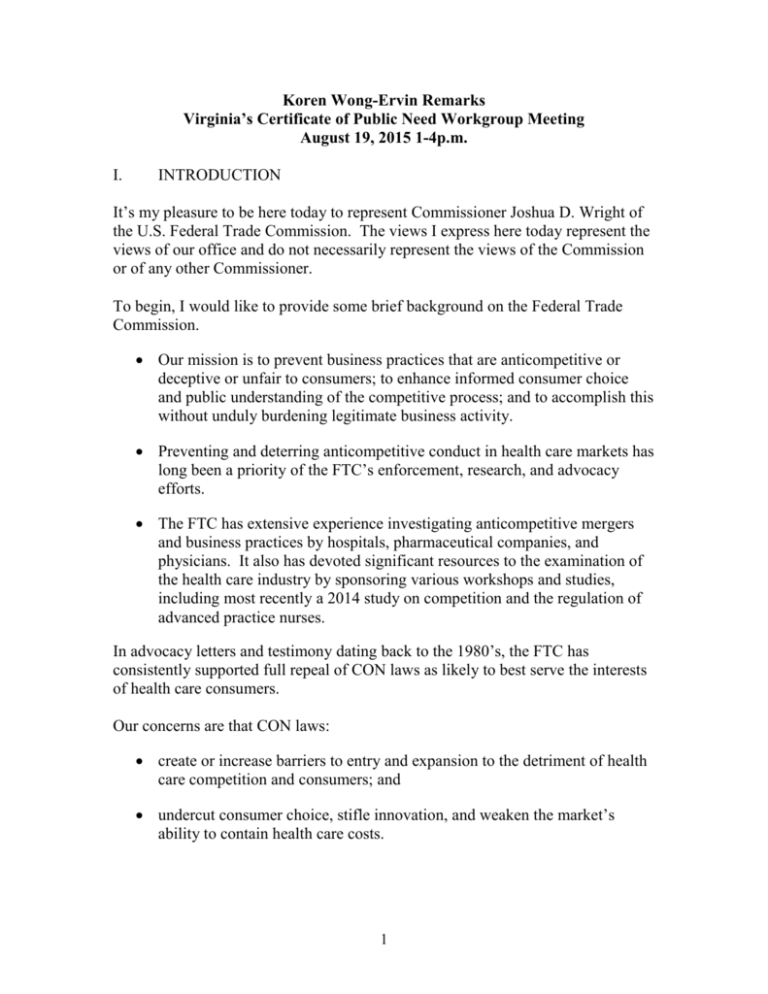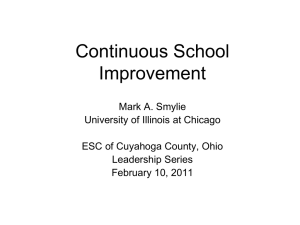Comments of Koren Wong-Ervin – Federal Trade Commission
advertisement

Koren Wong-Ervin Remarks Virginia’s Certificate of Public Need Workgroup Meeting August 19, 2015 1-4p.m. I. INTRODUCTION It’s my pleasure to be here today to represent Commissioner Joshua D. Wright of the U.S. Federal Trade Commission. The views I express here today represent the views of our office and do not necessarily represent the views of the Commission or of any other Commissioner. To begin, I would like to provide some brief background on the Federal Trade Commission. Our mission is to prevent business practices that are anticompetitive or deceptive or unfair to consumers; to enhance informed consumer choice and public understanding of the competitive process; and to accomplish this without unduly burdening legitimate business activity. Preventing and deterring anticompetitive conduct in health care markets has long been a priority of the FTC’s enforcement, research, and advocacy efforts. The FTC has extensive experience investigating anticompetitive mergers and business practices by hospitals, pharmaceutical companies, and physicians. It also has devoted significant resources to the examination of the health care industry by sponsoring various workshops and studies, including most recently a 2014 study on competition and the regulation of advanced practice nurses. In advocacy letters and testimony dating back to the 1980’s, the FTC has consistently supported full repeal of CON laws as likely to best serve the interests of health care consumers. Our concerns are that CON laws: create or increase barriers to entry and expansion to the detriment of health care competition and consumers; and undercut consumer choice, stifle innovation, and weaken the market’s ability to contain health care costs. 1 In addition, CON laws appear to have generally failed in their intended purposes of controlling growing health care costs, increasing quality of health care, and ensuring access to care for uninsured and underinsured in urban and rural areas. II. THE BENEFITS OF COMPETITION IN HEALTH CARE MARKETS • In 2003, the FTC-DOJ held health care hearings during which we obtained substantial evidence about the role of competition in our health care delivery system and reached the conclusion that vigorous competition among health care providers promotes the delivery of high-quality, costeffective health care. • Competition results in lower prices and broader access to health care and health insurance, while non-price competition can promote higher quality. • Competition has also brought consumers important innovations in health care delivery. • Basic economic theory, supported by a large body of empirical work, is unequivocal in its teaching that regulatory barriers to entry are, in general, harmful to competition and consumers. • Decades of empirical work are consistent with this view of state imposed regulatory barriers and show they are likely to lead to higher prices, reduced consumer choice, and provide few if any consumer benefits in terms of increased quality. • As such, regulatory barriers to entry should be avoided absent compelling empirical evidence demonstrating the regulation at issue will reduce the harm to competition and consumers arising from an existing market failure or promote another clearly articulated justification. • Here, there is no evidence of market failures. For one thing, hospitals do not lack incentives to make sound economic decisions. • Indeed, the original cost-control reasons for CON laws no longer apply. • Many CON law programs trace their origin to a repealed federal mandate, the National Health Planning and Resources Development Act of 1974, which offered incentives for states to implement CON programs. Virginia enacted its first CON program in 1973. 2 • • At that time, the federal government and private insurance reimbursed health care predominantly on a cost-plus basis (i.e., reimbursement for services were based on the costs of production), which provided incentives for over-investment and unnecessary expansion in exchange for greater reimbursement. • This is a very important point. The original reason for CON laws was not that competition inherently does not work in healthcare or that market forces promote over-investment. Instead, CON laws were desired because the reimbursement mechanism, i.e., cost-plus reimbursement, incentivized overinvestment. The hope was that CON laws would compensate for that skewed incentive. • Since the 1970s, the reimbursement methodologies that may in theory have justified CON laws initially have significantly changed. The federal government, as well as private thirdparty payors, no longer reimburse on a cost-plus basis. Instead the reimbursement system has shifted to fee-forservice. • In 1986, Congress repealed the National Health Planning and Resources Development Act of 1974. And health plans and other purchasers now routinely bargain with health care providers over price. Essentially, government regulations have changed in a way that eliminates the original justification for CON programs. • Moreover, even if there is some purported market failure, why do we believe that government regulation will result in the optimal level of capital expenditures? • Health care markets, medical technology, and consumer preferences are constantly changing. Shackling the industry with excessive regulation that only achieves higher costs and lower consumer welfare is not the solution. Furthermore, to the extent regulatory barriers purport to pursue noneconomic goals, these goals are usually better achieved through other mechanisms that do not impose substantial costs to competition and consumers. 3 III. CON LAWS ARE AN IMPEDIMENT TO HEALTH CARE COMPETITION • CON laws are a regulatory barrier to entry that inherently impedes health care competition and the benefits that flow from such competition. • First, like any barrier to entry, CON laws interfere with the entry of firms that could otherwise provide higher-quality services than those offered by incumbents. • This may tend to depress consumer choice between different types of treatment options or settings, and it may reduce the pressure on incumbents to improve their own offerings. • By interfering with the market forces that normally determine supply of services, CON laws tend to suppress competition and shield incumbent health care providers from new entrants. As a result, they can: • • Delay, and raise the cost of, entry by firms that are potentially able to offer new, more cost-effective, or higher quality services; • Reduce the ability of the market to respond to consumer demand for different treatment options, settings, or prices; and • Remove or delay the competitive pressures that typically incentivize incumbent firms to innovate, to improve existing services, or introduce new ones. Indeed panelists at the 2003 FTC-DOJ health care hearings provided real-world examples of these potential, negative consequences of CON programs. • For example, one panelist described how a CON program limited access to cancer treatments and placed “vital therapies and technologies out of [consumers’] reach” in favor of “old technologies.” • Another panelist described how her state’s CON law had enabled incumbents to charge more for services and shielded them from the need to offer new and more innovative services. 4 • Second, CON laws can be subject to various types of abuse, creating additional barriers to entry, as well as opportunities for anticompetitive behavior by private parties. • • For example, existing competitors can exploit the CON process to thwart or delay new competition to protect their own supracompetitive revenues. • During the 2003 FTC-DOJ health care hearings, the Agencies heard testimony that existing firms can easily use the CON process “to forestall competitors from entering an incumbent’s market.” • Incumbent providers may use the hearing and appeals process to cause substantial delays in the development of new health care services and facilities. Such delays can lead both the incumbent providers and potential competitors to divert substantial funds from investments in such facilities and services to legal, consulting, and lobbying expenditures, which in turn have the potential to raise costs and delay or prevent the establishment of new facilities and programs. Additionally, the CON process may facilitate anticompetitive agreements. • For instance, in 2006, the DOJ alleged that a hospital in Charleston, West Virginia used the threat of objecting during the CON process, and the potential ensuing delay and cost, to induce another hospital seeking a CON for an open heart surgery program not to apply for it at a location that would have well served Charleston consumers. • In another case from West Virginia, the DOJ alleged that two closely competing hospitals agreed to allocate certain health care services among themselves. The informal urging of state CON officials led the hospitals to agree that just one of the hospitals would seek approval for an open heart surgery program, while the other would seek approval to provide cancer treatment services. • In another case, two Vermont home health agencies entered into anticompetitive market allocation agreements. Absent Vermont’s CON law, competitive entry might have disciplined such behavior. DOJ found that the anticompetitive 5 agreement caused consumers to pay higher prices for home health services than in states where home health agencies competed against each other. • IV. Third, CON laws can impede effective antitrust remedies • As the FTC’s recent experience in FTC v. Phoebe Putney demonstrates, CON laws can entrench anticompetitive mergers by limiting the ability to implement effective structural remedies. • Phoebe Putney involved a challenge to the merger of two hospitals in Albany, Georgia. The FTC alleged that the merger had created a monopoly in the provision of inpatient general acute-care hospital services sold to commercial health plans in Albany and its surrounding areas, but ultimately was unable to achieve a remedy that would have restored competition to the marketplace due to Georgia’s CON laws and regulations. • As the Commission explained in its statement on the matter, “[w]hile [divestiture] would have been the most appropriate and effective remedy to restore the lost competition in Albany and the surrounding six-county area from this merger to monopoly, Georgia’s [CON] laws and regulations unfortunately render a divestiture in this case virtually impossible.” • The Commission statement further noted that the case “illustrates how state CON laws, despite their original and laudable goal of reducing health care facility costs, often act as a barrier to entry to the detriment of competition and healthcare consumers.” EVALUATING THE EFFECTIVNESS OF CON LAWS • CON laws also appear to have generally failed in their intended purpose of containing costs. • The effectiveness of CON laws may be evaluated on many dimensions, including whether they facilitate cost-reduction, increased quality, and improved access to care. Unfortunately, most states do not have appropriate mechanisms to track their progress in these areas. • However, as outlined in Commissioner Wright’s recent submission to the North Carolina legislature, available empirical research shows that with respect to cost-reduction, CON laws have generally failed to reduce costs and, in states with stringent CON laws, the stringency of the program is positively and significantly related to hospital costs. 6 • On average, states with CON programs regulate 14 different services, devices, and procedures. Virginia’s CON program currently regulates 19 different services, devices, and procedures, which is more than the national average, and ranks 11th most restrictive in the United States. • CON laws are also correlated with fewer hospital beds. Throughout the United States, there are approximately 362 beds per 100,000 persons. However, in states such as Virginia that regulate acute hospital beds through their CON programs, a study by Thomas Stratmann and Jacob Russ found 131 fewer beds per 100,000 persons. In the case of Virginia, with its population of approximately 8.26 million, this could mean about 10,800 fewer hospital beds throughout the state as a result of its CON program. • In addition, several basic health care services that are used for a variety of purposes are limited because of Virginia’s CON program. Across the United States, an average of six hospitals per 500,000 persons offer MRI services. In states such as Virginia that regulate the number of hospitals with MRI machines, the number of hospitals that offer MRIs is reduced by 2.5 per 500,000 persons. This could mean 41 fewer hospitals offering MRI services throughout Virginia. • Virginia’s CON program also affects the availability of CT services. While an average of nine hospitals per 500,000 persons offer CT scans, CON regulations are associated with a 37% decrease in these services. For Virginia, that could mean approximately 58 fewer hospitals offering CT scans. • In addition, a recent study focused on cardiac care found no evidence that CON laws are associated with higher quality care and that repealing CON laws is associated with more providers statewide and lower mean hospital volume for both coronary artery bypass graft surgery and percutaneous coronary interventions, or PCIs. • CON laws also restrict the number of cardiac facilities and are associated with 19.2% fewer PCIs per 1000 elderly, equivalent to 322,526 fewer PCIs for 1989-2002. • In sum, the available empirical evidence on the effects of CON laws indicate they are likely to harm consumers by reducing competition and decreasing access to and quality of care without providing any offsetting benefit such as reducing health care costs. 7 V. CON LAWS ARE UNNECESSARY TO PROVIDE HEALTH CARE SERICES TO THOSE WHO CANNOT AFFORD THEM • Lastly, CON laws are unnecessary to provide health care services to those who cannot afford them. • Incumbent hospitals often argue that they should be protected against additional competition so that they can continue to cross-subsidize care provided to uninsured or underinsured patients. • Under this rationale, CON laws should impede the entry of new health care providers that consumers might enjoy for the express purpose of preserving the market power of incumbent providers. • The providers argue that without CON laws, they would be deprived of revenue that otherwise could be put to charitable use. • We fully appreciate the laudable public-policy goal of providing sufficient funding for the provision of important health care services—at community hospitals and elsewhere—to those who cannot afford them, and for whom government payments are either unavailable or too low to cover the cost of care. But at the same time, the imposition of regulatory barriers to entry as an indirect means of funding indigent care may impose significant costs on all health care consumers, including those who might otherwise benefit from additional competition in health care markets. • Moreover, recent academic literature does not show evidence of crosssubsidization taking place. The most comprehensive empirical study to date, conducted by Stratmann & Russ, finds no relationship between certificates of need and the level of charity care. • Moreover, CON requirements are very broadly and do not target specific, documented social needs (such as indigent care). Solutions more narrowly tailored to the state’s recognized policy goals may be substantially less costly to consumers than the current CON regime. For example, the 2007 Lewin Group report commissioned by Illinois identifies various alternatives that may be more efficient to advancing such goals. VI. CONCLUSION • In closing, 40 years of evidence demonstrate that CON programs do not achieve their intended outcomes, but rather decrease the supply and availability of health care services by limiting entry and competition. 8 • As such, we support full repeal of Virginia’s CON law or, at the very least, substantial narrowing as likely to best serve the interests of health care consumers. 9






